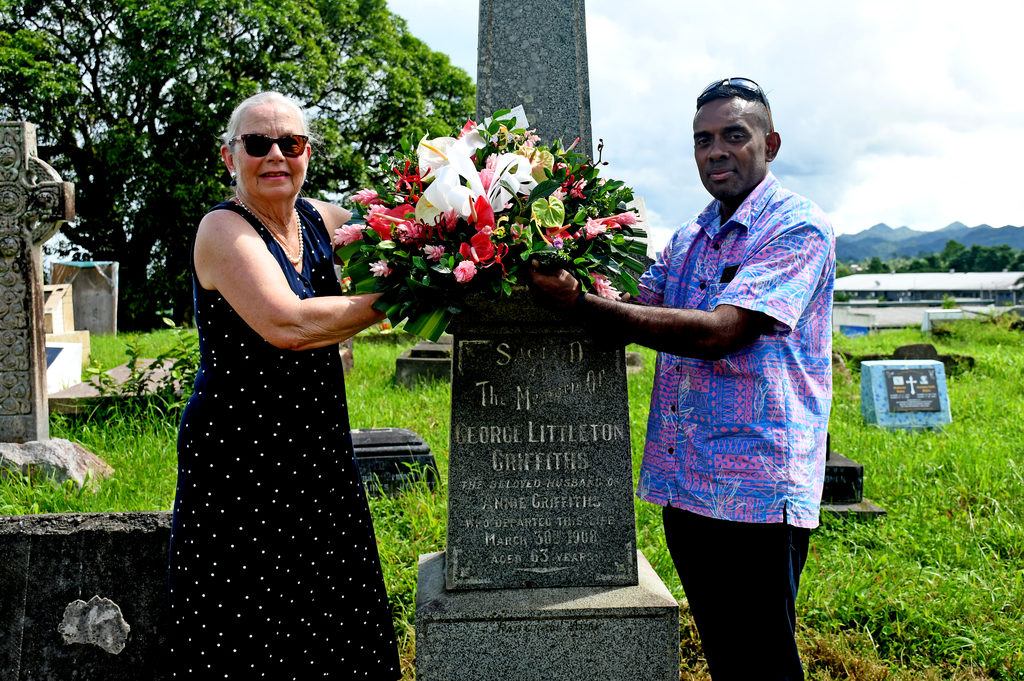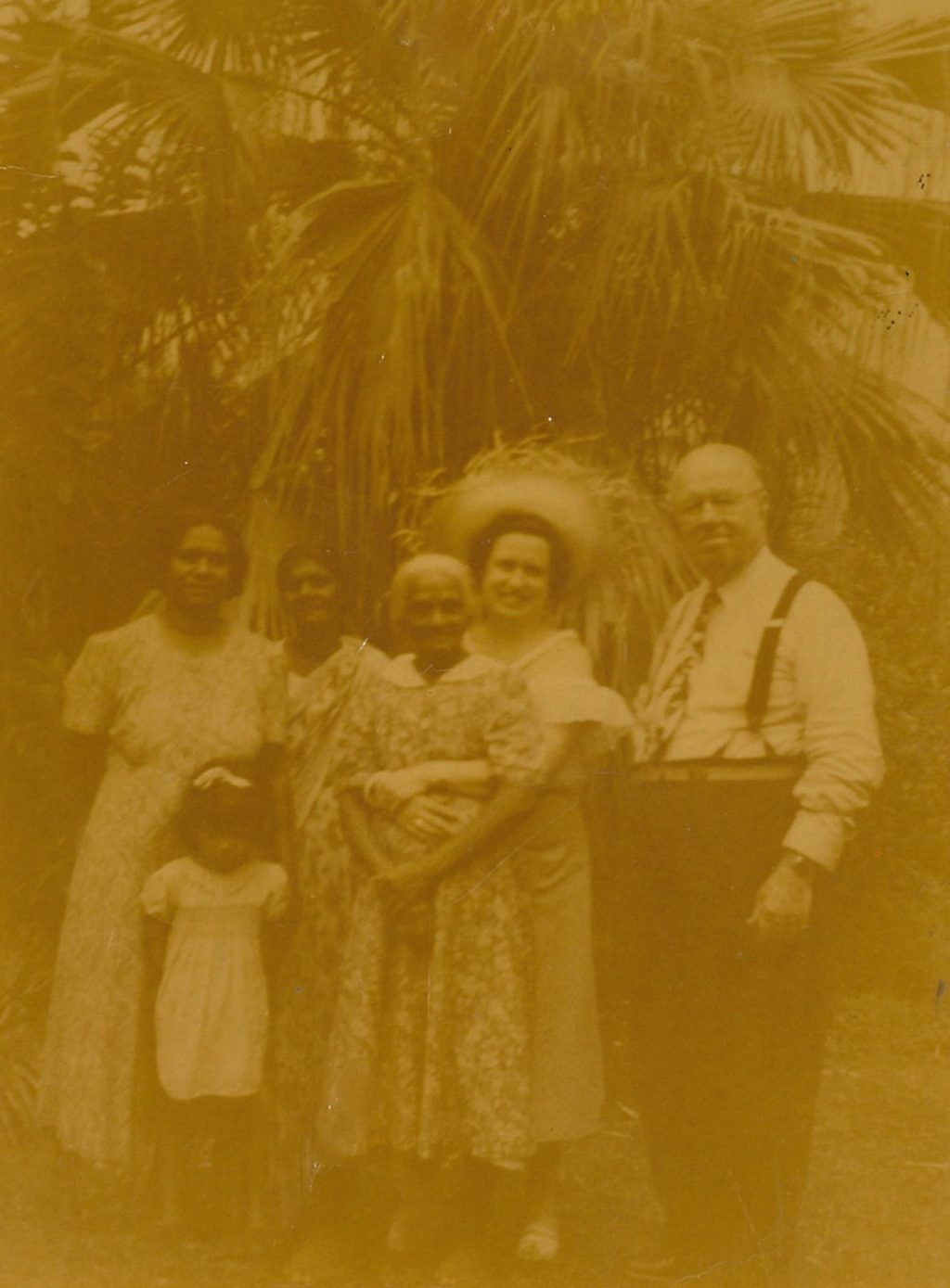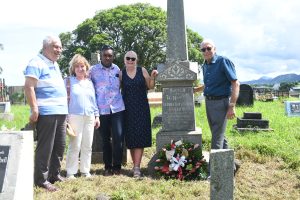There was something about Caroline Datsopoulos’ smile when we first met at The Fiji Times boardroom. It was her first time in Fiji, yet her family had played a significant role in shaping this nation long before her arrival.
Despite it being our first encounter, I am fortunate to say Caroline and I go back a long way. Our paths intersect through family history—she, a descendant of George Littleton Griffiths (G.L.G.), and I, a descendant of Satina Emily Griffiths, G.L.G.’s adopted daughter.
Satina was dearly loved by the Griffiths family, including Caroline’s grandmother, Ciwa.
When Caroline visited the newspaper company her great-grandfather founded in 1869, she brought with her an album of old photographs belonging to Ciwa. I held back my emotions. I had never met a member of the Griffiths family, though I had spoken their name many times in conversation.
My imagination took me back to Levuka in 1883—the old capital, with its horses, wooden carriages, and quaint cottage-like buildings clustered along the beachfront. That was where my great-grandfather Koi, a teenage boy, disembarked from a blackbirding ship on Ovalau Island.
G.L.G., known for his generosity, was the owner of Fiji’s first newspaper company since 1869. He took Koi into his service, plucking him from the sea of recruits. In 1886, Satina, only eight years old, arrived on another ship with her family.
She was rescued by Mr. Griffiths, who adopted her as his own daughter.
Fast forward a few decades, and I find myself standing beside Caroline. I’ve always been deeply fascinated with uncovering my past. The Koi family hails from Buka, in Bougainville, but Fiji has been our home for more than four generations. I never imagined I would get the chance to mend a forgotten link—rekindle a lost connection.
Our family records contain written materials about our beginnings, all starting with Koi and Satina. Elders tell us of how the family grew, spreading across Fiji and abroad. Newtown in Nasinu became our family headquarters.
While many family stories have humble beginnings, ours is one of resilience and survival—much like G.L.G., who left his homeland to build a new life in Fiji. While G.L.G. came seeking opportunity, my great-grandparents’ journey was driven by necessity. I believe fate brought G.L.G. to them; many others on those ships were not so fortunate.
“The Parting of Ways”
A story relayed by my grandmother, Violet Margret Koi (Satina’s youngest daughter), speaks of a bittersweet farewell when the Griffiths family left to return to the United Kingdom. Satina and Koi, married at the time, were left behind with the family’s large home in Flagstaff. They had ten children and had to learn to survive in the new environment of Suva on their own.
Caroline and I later revisited the gravesite of the late G.L.G. at the old Suva Cemetery. I imagined the surrounding area — less crowded, with more trees — once filled with graves. G.L.G.’s resting place sits atop a hill with a beautiful view of the foreshore near the Royal Suva Yacht Club. I pictured his children standing there, the same spot where he was laid to rest, with Satina likely present too.
Standing there with Caroline, accompanied by her husband George, and friends Marion and Terry Caloghiris from Greece, I reflected on our shared history.
Satina Griffiths
Satina Emily Griffiths was born in 1878, possibly in India or Demara in the West Indies. She was brought to Fiji aboard the indenture ship Boyne No. 471 in 1886, at just eight years old, traveling with her mother Jeelaba, 32, and her younger brother, four.
There was also an infant boy, Miwa. Records indicate they were children of Woozeer or Wazeer. Jeelaba worked for the Colonial Sugar Refining Company in Rewa for two years before passing away, as reported by my late father, Vivian Koi, in The Fiji Times.
The background of Satina’s family remains uncertain, partly because personal records of indentured laborers were often incomplete or handled swiftly, especially given the conditions of those voyages.
In Dr. Anurag Subramani’s The Fiji Times at 150, he describes the Griffiths family’s reputation for generosity and compassion. Arthur Griffiths, G.L.G.’s son, recounts in his memoir that the household was known for its hospitality — helping the hungry with a generous stockpot, and taking in orphaned children out of kindness. This included Satina, who was adopted in Levuka.
When the family moved to Suva, Satina, then 16, married Regi Griffiths, aged 27, on April 4, 1894. Satina passed away on November 24, 1956, after an illness.
Koi’s Journey
Koi, originally from Ombi Village in Bougainville, disembarked from a blackbirding ship in 1883.
At just 16, his life was about to change forever. Arthur Griffiths describes him as “a big fellow at 17,” with a “pleasing smile” that won hearts. He was active and eager to help, quickly learning household chores and becoming a trusted servant.
Koi’s recruitment was overseen by Old Paddy Meogh, a boatswain, on the notorious South Sea blackbirding vessel Megmelilies, commanded by ‘Bully’ Hayes. Over the past 150 years, the Pacific islands have been a hunting ground for blackbirders.
When Koi arrived in Levuka, the Griffiths family was notified. Arthur Griffiths recalls accompanying his father to see the young recruit. Koi was well-pleasing in appearance and eager to serve, quickly earning the affection of the household, especially in the kitchen.
In 1886, Koi’s indenture expired, and he was paid off. Many others recruited at the same time also gained their freedom to work and live as they chose. Several Buka boys who had made the journey gathered at the Griffiths’ servant’s bureau to discuss their futures.
G.LG’s wife, Mrs Griffiths, was saddened to see Koi leave, but to her surprise, Koi and the other men chose to follow the Griffiths family when they moved to Suva.
Family members reunite … Caroline Datsopoulos and Harold Koi place a wreath at the head stone of the late George Littleton Griffiths at Suva Cemetery (Lovonilase).
Picture: JONA KONATACI

One of the last photographs taken of Satina Griffiths (front). Picture: KOI FAMILY


 (L-R) Terry and Marion Caloghiris, Harold Koi, Caroline and George Datsopoulos at G.LG’s gravesite in Suva. Picture: JONA KONATACI
(L-R) Terry and Marion Caloghiris, Harold Koi, Caroline and George Datsopoulos at G.LG’s gravesite in Suva. Picture: JONA KONATACI
